
 Back to Fortification Theories, etc.
Back to Fortification Theories, etc.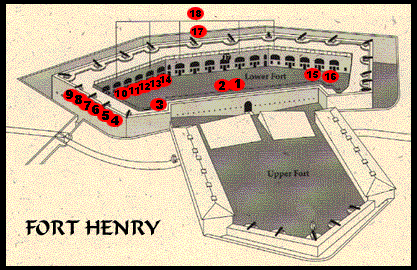
| 1. Garrison Cell | 2. Men's & Women's Privies |
| 3. Officers' Kitchen | 4. Junior Officers' Quarters |
| 5. Commandant's Room | 6. Anteroom |
| 7. Officers' Mess | 8. Wine Cellar |
| 9. Reverse Firing Chambers | 10. Barracks Room |
| 11. Schoolroom | 12. Bakery |
| 13. Married Quarters | 14. Cookhouse |
| 15. Water Pump | 16. Powder Magazine |
| 17. Caponier | 18. Strong Walls of Redoubt |
Fort Henry was a hybrid of the Vauban and Polygonal system. The "new" Fort Henry was built between the years 1832–1837, at a cost of £70,000 British pounds sterling, which is equivalent to about $35,000,000 in today’s currency. The lower fort is sunken into the hill.

Most of the fort’s guns face inland, or to the north, because the designers felt that the Americans were not likely to mount an amphibious invasion due to the presence of the Royal Navy in the harbour and the guns of the Advanced Battery. Instead, it was believed that the invaders would cross the St. Lawrence River where it was narrow and then proceed down the Canadian shore until they appeared on the eastern approaches to the city.

In 1832, Bryce ordered the commander of the Royal Engineers in Canada, Colonel Gustavas Nicols, to review the earlier plans for the defence of Kingston. The budget was to be taken into consideration. Here are the changes Nicols made, for his plan that was later adopted:
 The north front had now three faces instead of two, and two counterscarp
galleries instead of three. The north front had now three faces instead of two, and two counterscarp
galleries instead of three. |
 an added caponier. an added caponier. |
The elements of the new Fort Henry:
 six 18-pounder carronades protected the east and the west ditches six 18-pounder carronades protected the east and the west ditches |
 302 loopholes 302 loopholes |
 a garrison of 338 housed in bombproof casemates. a garrison of 338 housed in bombproof casemates. |
 a magazine of 1,250 barrels of gunpowder. a magazine of 1,250 barrels of gunpowder. |
 Storage tanks containing 62,000 gallons of water Storage tanks containing 62,000 gallons of water |
Structurally, the redoubt was strong. The only portions susceptible to direct fire were the parapets. To solve this problem, the north side, which was most vulnerable to direct hits, was constructed of stone 12 feet thick. The heaviest guns would have to fire many rounds to smash the parapets.
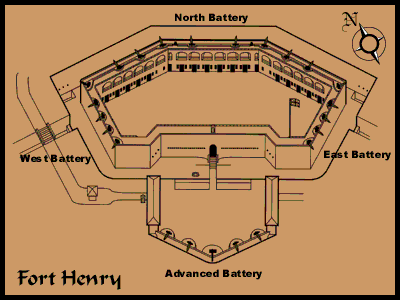
The Advanced Battery was made up of nine 32-pounder guns, protected by a deep ditch and rifle galleries .They were bombproof and pierced with 75 loopholes for close-in defence.
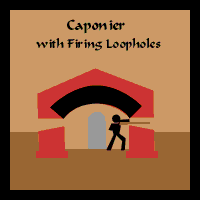
With its guns positioned 100 feet above lake level, it had the equivalent firepower of a 50-gun ship, without any of the wooden ship's defects. It could cover a cone which extended south and west, in front of the harbour and Rideau Canal entrance.
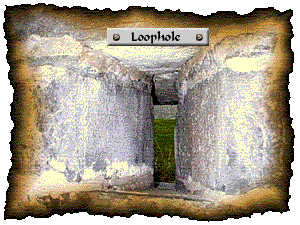
The citadel consisted of two fire units, armed with basically the same weapon: a smoothbore muzzle-loading gun with an effective firing range of 1,200 yards. The Redoubt and Sea Battery were mutually supporting in so far as the glacis was concerned. The glacis was the area surrounding the fort that was in point-blank range.

The East and West Batteries were perched the highest, at 120 feet above the water. From here they could support Cathcart Tower on Cedar Island, as well as the low ground in the rear which had a weak land front.
For close-in defence, there were the carronades which, loaded with canister, could fire 50 to 100 eight-ounce balls within the confining wall of the branch and the east and west ditches.
There were also some weak points. The thin underbelly of the redoubt, where the thin curtain wall mounting held no heavy armament, contained the only entrance. There was a good chance that a surprise attack or a serious attack could be successful.
Two solutions to this were applied. Firstly, two small towers were constructed at the end of the branch ditches with a short 24-pounder in each. This was designed to cover the dead ground along the shore where an enemy might skirt around the ends of the ditches. Secondly, in the 1860s, the curtain wall was raised and loop-holed.
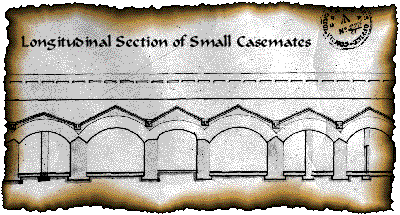
There was another area which the Redoubt could not cover: the water space between Cedar Island and the promontory at the head of the island. Again there were two solutions. Firstly a number of mortars were added. These weapons could deliver explosive shells to these areas. Secondly, in 1871, a 7-inch gun was mounted in the fort's northeast salient. It was specially mounted in order to deliver a 110-pound shell with a 180-degree traverse.
The myth that Fort Henry was built backwards seems to stem from the fact that the fortification, without the other mutually supporting redoubts and towers for land defence, gave the impression that it is not defending a position.
In 1860, Captain R.E. Wittingham, wrote in a letter to his superiors that the introduction of rifled guns of much greater range might require that the structure of the fort be altered. He was not far from the truth. Despite the cost and the fine planning, the fort's true effectiveness lasted only 25 years. It was outdated by the rapid progress of military technology in the 1860s.
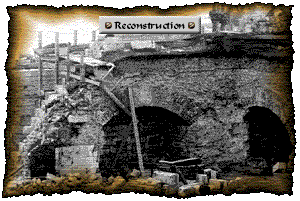
But up until that time it represented the state of the art of war.
![]()